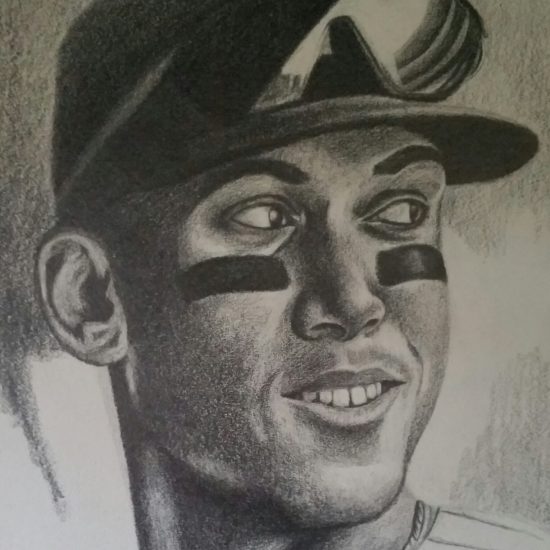Ok, all things considered, the title might be a little hyperbolic. Of course, the PLV metrics love hitters like Aaron Judge, Yordan Alvarez, and Mike Trout. But I’m guessing you already figured that out. So what follows might better be described as a list of hitters that PLV might, if it were capable of such things, love relative to their respective ADP.
A ton of things went into PLV, to learn more about it, make sure to read Nick Pollack’s primer. Full disclosure, I’m still very new to it all, too. To give a really general idea, the PLV metrics provide a unique way to quantify hitter performance by measuring the quality of each individual pitch as a barometer.
As with anything new, definitions are a good place to start, so they’re here straight from the source.
Swing Aggression: How much more often a hitter swings at pitches, given the swing likelihoods of the pitches they face.
Strikezone Judgement: The “correctness” of a hitter’s swings and takes, using the likelihood of a pitch being a called strike (for swings) or a ball/HBP (for takes).
Decision Value (DV): Modeled value (runs per 100 pitches) of a hitter’s decision to swing or take, minus the modeled value of the alternative.
Contact Ability: A hitter’s ability to make contact (foul strike or BIP), above the contact expectation for each pitch.
Power: Modeled number of extra bases (xISO on contact) above a pitch’s expectation, for each BBE.
Hitter Performance (HP): Runs added per 100 pitches seen by the hitter (including swing/take decisions), after accounting for pitch quality.
One thing I searched for was hitters that didn’t get great results but were doing good things at the plate, i.e., favorable swings and takes. In which case, Anthony Rendon stuck out. We haven’t seen him at his best in a long time. In 2021, he dealt with a knee bruise, hamstring strain, and hip impingement that held him to 58 games.
Last year, he tried to come back from a wrist injury before opting for surgery in mid-June after only 47 games played. We were left with a career-low .706 OPS backed by sub-par batted ball metrics and a K rate that spiked to over 18%, a few ticks above his career average. In all, it was a flimsy sample that was almost certainly skewed by an ailing wrist.
The important piece, to me at least, is that his decision value still graded out really well. Despite the dip at the tail end, he still finished with a season average in the 90th percentile. On the 20-80 scale, he was one of seven hitters who graded out at 75 or higher; His former teammate Juan Soto was the only one with an 80-grade.
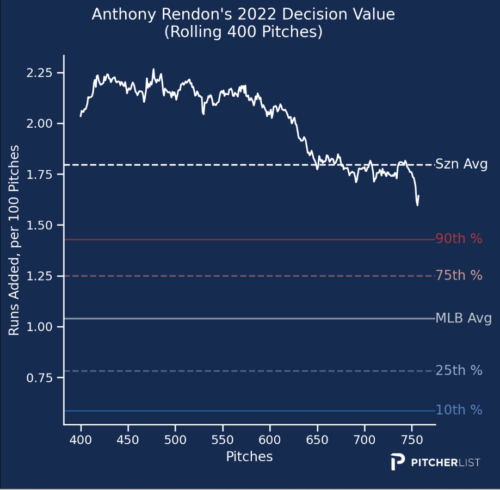
Assessing Rendon is a conundrum because of the injuries over the last two years. It’s not ideal, but I think the best option is to view 2020 as a rough blueprint. During the short season, he hit .286 with a .915 OPS, and his PLV marks support the performance, with the low point being a 50 grade in power. That’s the one area where Rendon might not have a great ceiling, as his 34 home runs in 2019 were almost certainly an outlier.
Although last year’s sample was short, his 75-grade in decision value demonstrated that he still has an elite ability to attack favorable pitches. Assuming a full recovery, Rendon’s RBI ceiling as a career .285 hitter makes for an attractive target in the late rounds.
Among the 49 catchers with 200 PA last year, Jansen’s .855 OPS ranked second behind William Contreras‘ .860. His .256 ISO ranked second behind Cal Raleigh’s .278. But Jansen’s production, which included a career-best 15 dingers, came with a much lower K rate of 17.7%.
An oblique injury and a broken finger had him shelved for much of the first half. But he really took off late, producing a 1.007 OPS over his final 25 games.

He finished the 2022 season as one of 16 hitters with a hitter performance (HP) grade of 70 or higher. Granted, it was a much smaller sample size (248 PA or 956 total pitches), but the Blue Jays’ backstop found himself amidst elite company.
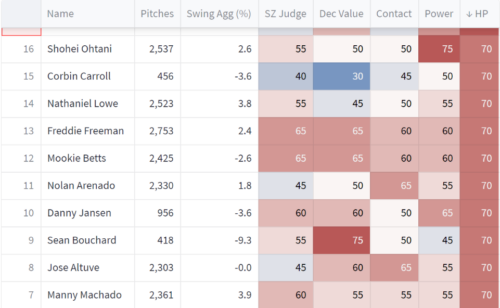
As Ben Pernick mentioned in his Bold Predictions, Jansen’s statcast numbers popped across the board. It’s not uncommon to see catchers peak a little bit later as hitters, so he might be reaching that point now. A reasonable HR/FB rate of 16.9% and exemplary PLV metrics support what could have been a low-key breakout last year.
Assuming 400 plate appearances, an outcome of 25 or so home runs seems reasonable, given that he has a career flyball rate of 43.2%, well above last year’s 33.5% MLB average.
But therein lies the rub; projecting Jansen’s playing time is dicey with stud catcher Alejandro Kirk and Brandon Belt siphoning DH at-bats. Playing time risk aside, Jansen’s power potential in one of the best lineups in baseball makes him an intriguing gamble; The Bat X projects him for 18 home runs in 407 PA, tied with J.T. Realmuto and M.J. Melendez for seventh among catchers.
Similar to Rendon, Jesse Winker’s 2022 season, was derailed by injuries. But unlike Rendon, it doesn’t seem like we really knew the extent of it until after the season. He had two surgeries—a meniscus repair in his left knee and the other a disc replacement surgery in his neck.
Apparently, he had been dealing with discomfort in his neck for the past three seasons before he finally reached the breaking point last year. As you might’ve figured, it’s an uncommon procedure that is seen more often in football and hockey players. But the good news is that he’s ready for the upcoming season.
The easy argument to make against Winker is that he struggled in the shift from an extreme hitter’s park at the GABP to T-Mobile Park in Seattle. As far as park factors go, it was a big shift down. But knowing that he had two procedures done, I’m inclined to give him a pass. His average EV dropped nearly three mph. It’s such a steep decline that it makes me believe he wasn’t at full strength.
While the results weren’t there, Winker did at least one thing really well, and that was swinging at the pitches that you want to swing at. In that regard, he finished above the 90th percentile.
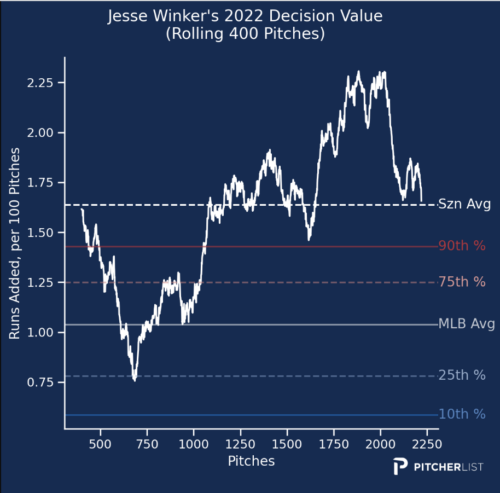
An intercostal strain cost him about a month of the 2021 season, another example of his not-great injury history. Nevertheless, he posted a career-best .950 OPS across 110 games. Yes, the GABP helped. But take a look at his home/road splits, they weren’t as lopsided as you might’ve guessed.
In 2021, Winker was one of the 18 hitters that PLV graded with a 70 Hitter Performance or better (20-80 Scale). As you can see in the table sorted by HP, he was with some great company.
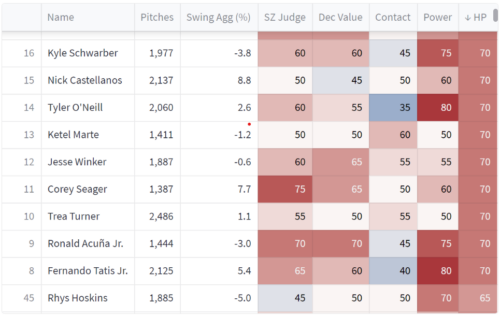
Not pictured, staring down at everyone is Mike Trout at 80, followed by Vladimir Guerrrero Jr., and Bryce Harper, both at 75, you get the idea. Of course, that’s not Winker’s baseline, but it illustrates his upside. He’s also back in a more favorable home park of American Family Field, which ranked fourth-best last season in Statcast’s HR factor for lefties. Don’t ignore him in the late rounds, especially in daily formats where you can bench him against lefties.
A former first-round pick out of Fresno State in 2015, Taylor Ward broke out in a big way last year and finished with a .833 OPS, tied for 20th with Xander Bogaerts among qualifiers. He also held a chase rate in the 95th percentile, illustrating his uncanny ability to discern a ball from a strike. He was also one of just 16 batters last year that PLV tracked with a Decision Value grade of 70 or better. As you can see below, he finished well above the 90th percentile in that respect.
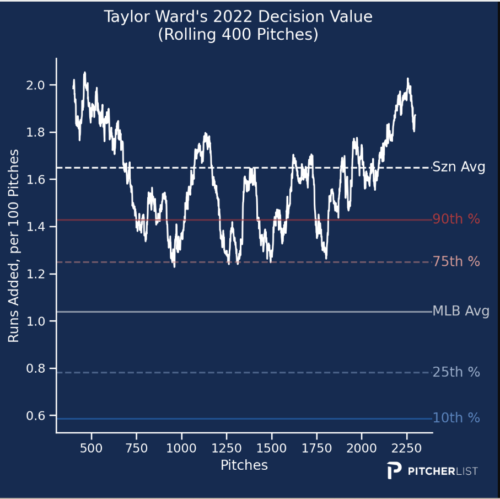
Last year’s results were odd. After a torrid April and May, during which he accrued a 1.145 OPS over 146 PA, the bottom fell out. From June through August, he posted a .624 OPS across 292 PA. The cratering is depicted below.

Still, he recovered toward the end and finished with a hitter performance over the 90th percentile, 65 on the 20-80 scale. You could certainly reason that it might have been a product of an unsustainable stretch early on. But Ward provided some context in September when he admitted that he was finally feeling strong again after banging into a wall on May 20th. Surely enough, he spiked again late and hit .345 with a .872 OPS over his last 31 games.
The drought he had during the middle months has thrown at least some doubt over his breakout. But the injury provides some much-needed context.
Adding another wrinkle, his contact % spiked in the second half. Given that K rates stabilize quickly and the spike leveled off, I’m thinking it was just a blip. Either way, it’s an interesting footnote you can see below.
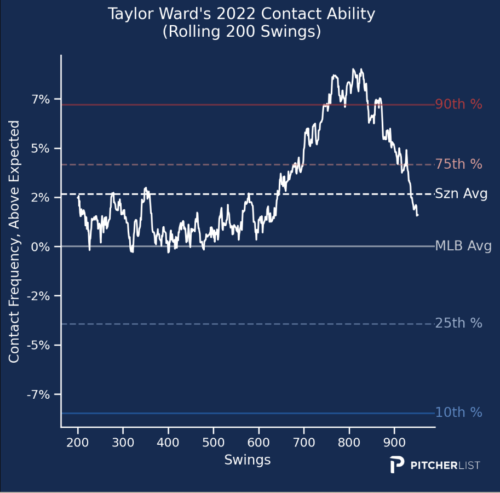
Most projections have him around 22 home runs, more or less a repeat of last year. But given how well he graded out when he was at full strength, I’m curious to see what he can do while hale over a whole season. As is, he’s a good bet for OBP and runs atop the Angels lineup. But he might have the power to approach 30 home runs if last year’s peaks at the beginning and end were any indication.
An interesting footnote: this offseason, the Angels recently hired Trent Woodward, the private hitting coach to whom Ward accredits his renaissance, as a team consultant.
Vinnie Pasquantino has gotten a ton of hype this off-season, and PLV agrees. He’s a really unique profile in that he was one of just 20 hitters with a 70-grade in contact and the only one who also carried a 65-grade in HP. He’s an excellent high-floor option at first base.
But, you can grab a very similar sort of profile a bit later in Ty France. As seen below, their grades stack up similarly across the board.
The one difference is in walk rate, in which case Vinnie P gets a boost if you’re in an OBP league. But France might be the better bargain in standard 5×5. Take a look at their projections on the Bat X.
If you rostered France last season, you might recall his disappearing act in the second half, depicted below in gruesome detail. In the first half, he hit .308 with a .846 OPS. And in the second half, he hit .229 with a .677 OPS as his HP bottomed out near the 10th percentile.
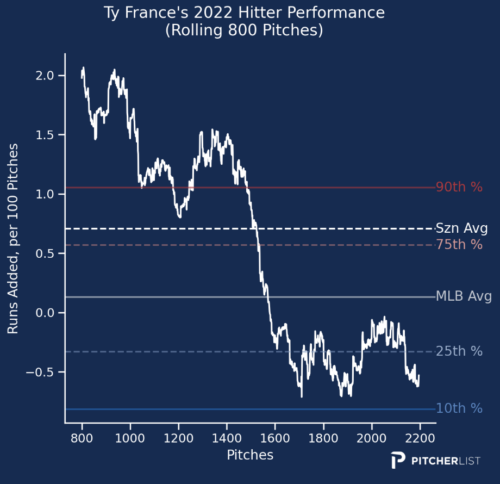
But his sagging performance is explained by an injury. “I spent almost the whole second half in the training room trying to fix my elbow and my wrist,” he said this past off-season. The injury happened when Sheldon Neuse ran into his arm while reaching for an errant throw at first.
He did go to the ten-day IL with a Grade two flexor strain, but he said that he never felt right even when he returned. He also had a separate issue with his wrist that lingered.
The good news is that he’s had a normal spring so far and has been working on reversing the bad habits he got into while trying to play through the pain. It might be best to take France’s final line with a grain of salt, knowing that he wasn’t at full strength. Considering his stellar HP in the first half, he looks like a bargain.
Quick Hits
I couldn’t narrow this down to just five hitters, so I wanted to include notes on other hitters that caught my attention from last season’s PLV data.
Yandy Diaz: One of just seven hitters with a 75 or better in decision value (Juan Soto was the lone hitter with an 80 grade). A very good real-life hitter who is terrific for OBP leagues, but otherwise, the 45 power grade drags down his upside.
Alex Bregman: Very similar to Diaz; an impeccable eye with a 75 in DV and 70 in Strike zone judgment. But unlike Diaz, his 41.6% Flyball rate gives him a fairly easy path to 25 home runs.
J.D. Davis: Remember his 2019 with the Mets? A .896 OPS across 140 games. Last year, he only hit 12 home runs in 365 PA, so he’s easy to gloss over, but he was one of just 21 hitters with a power grade of 70 or higher. He also had an SZ judgment rating of 75. The blemish is the 25-grade contact. He might be an interesting name to monitor if he can win the battle at 3B with David Villar.
Max Muncy: Just a .713 OPS last year with a .192 batting average, but he makes a lot of sense as a bounce-back candidate considering his 70-grade decision value.
Michael Harris II: The only real talking point against last year’s NL RotY is that he swings a ton; PLV confirms with a 30 in Strikezone Judgement and 35 in decision value. He’s only 22, so he could certainly improve in that area, but it’s also not hard to imagine some growing pains in year two.
Jorge Soler: If you look at his rolling charts, or, you know, rostered him, you’ll know he really fell off before succumbing to a back injury in July. But he still had a pretty decent eye at the plate with a 60 in Strikezone Judgement, so he’s not a bad bounce-back candidate, especially in OBP leagues.
80-Grade Power: Yordan Alvarez, Aaron Judge, Kyle Schwarber, Mike Trout. That makes sense. But there were two more…Trayce Thompson and Keston Hiura. Both of the latter, though, were plagued by low contact grades, with K rates well over 30%.
Sean Bouchard: Unfortunately, he ruptured his left biceps, so he’s out for the year. But the Rockies OF showed well in a very short sample last year (97 PA, 413 total pitches) with a 75-grade DV and 70 HP.
Michael Brantley: Dusty Baker’s preferred two-hole hitter did show well last year with a 65-grade DV, 70-grade Contact ability, and 55-grade HP before succumbing to a shoulder injury. A potential buyback assuming he recovers from surgery.
Brandon Belt: Now with the Jays, Belt owns a career .814 OPS and bashed a career-best 29 home runs across just 381 PA two seasons ago. Last year, the results weren’t there as he battled a knee injury, but he still had a 75-grade SZ Judgment and 70-grade DV. In 2021 and 2020, he had an 80-grade SZ Judgment. He probably doesn’t warrant attention in most leagues, given the lack of at-bats as a part-time DH. But, if we’re electing a veteran to have a resurgent season out of nowhere, Belt gets my vote.
Gunnar Henderson: The AL RoY favorite, Henderson showed a good eye at the plate with a 60-grade in SZ Judgment and 65-grade DV in a short sample (132 PA, 539 pitches).
Triston Casas: Another RoY candidate, Casas, showed a 60-grade SZ Judgment and 70-grade DV despite the lack of results during his very brief debut (95 PA, 411 pitches).
Oneil Cruz: Light tower power, but the 25-grade in SZ Judgment and 35-grade DV highlight weaknesses in pitch recognition.
George Springer: His walk rate fell below 10% for the first time in his career, so I was curious if PLV saw a decline. It did not, as the Jays leadoff man rated well with a 70-grade SZ Judgment and 65-grade DV.
Images courtesy of Icon Sportswire | Adapted by Aaron Polcare (@bearydoesgfx on Twitter)


